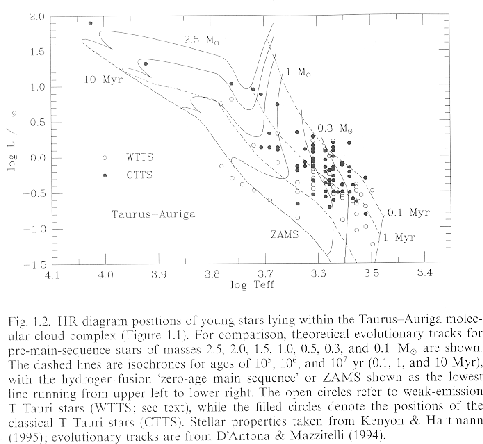



Next: Disk Frequency
Up: Introduction
Previous: Case Study
Contents
Figure 1.5:
HR diagram of T Tauri stars.
Many emission lines are found in the spectra of T Tauri stars.
WTTS (Weak Emission T Tauri Stars) and CTTS (Classical T Tauri Stars) are classified
by the equivalent widths of emission lines.
That is, the objects with an EW of H emission
emission  is usually termed a WTTS.
Taken from Fig.1.2 of Hartmann (1998).
is usually termed a WTTS.
Taken from Fig.1.2 of Hartmann (1998).
 |
T Tauri stars are observationally late-type stars with strong emission lines and
irregular light variations associated with dark or bright nebulosities.
T Tauri stars are thought to be low-mass pre-main-sequence stars, which are younger than the main-sequence
stars.
Since these stars are connecting between protostars and main-sequence stars,
they attract attention today.
More massive counterparts are called Herbig Ae-Be stars.
They are doing the Kelvin-Helmholtz contraction in which the own gravitational energies released as it contracts
gradually and this is the energy source of the luminosity.
Many emission lines are found in the spectra of T Tauri stars.
WTTS (Weak emission T Tauri Stars or Weak line T Tauri Stars)
and CTTS (Classical T Tauri Stars) are classified
by their equivalent widths (EWs) of emission lines.
That is, the objects with an EW of H emission
emission
 is usually termed a WTTS.
Figure 1.5 is the HR diagram (
is usually termed a WTTS.
Figure 1.5 is the HR diagram (
 ) of T Tauri stars
in Taurus-Auriga region (Kenyon & Hartman 1995).
WTTSs distribute near the main-sequence and CTTSs are found even far from the main-sequence.
A number of theoretical evolutional tracks for pre-main-sequence stars with
) of T Tauri stars
in Taurus-Auriga region (Kenyon & Hartman 1995).
WTTSs distribute near the main-sequence and CTTSs are found even far from the main-sequence.
A number of theoretical evolutional tracks for pre-main-sequence stars with
 are shown in a solid line, while the isochorones for ages of
are shown in a solid line, while the isochorones for ages of
 ,
,  , and
, and  are plotted in a dashed line.
Vertical evolutional paths are the Hayashi convective track.
Since D=
are plotted in a dashed line.
Vertical evolutional paths are the Hayashi convective track.
Since D= H has a much lower critical
temperature (and density) for a fusion nuclear reaction to make He than
H has a much lower critical
temperature (and density) for a fusion nuclear reaction to make He than  H,
Deuterium begins to burn before reaching the zero-age-main sequence.
This occurs near the isochrone for the age of
H,
Deuterium begins to burn before reaching the zero-age-main sequence.
This occurs near the isochrone for the age of  and some activities related to the ignition of Deuterium seem to
make the central star visible (Stahler 1983).
and some activities related to the ignition of Deuterium seem to
make the central star visible (Stahler 1983).
Subsections




Next: Disk Frequency
Up: Introduction
Previous: Case Study
Contents
Kohji Tomisaka
2007-07-08

